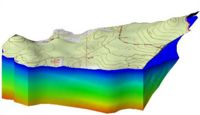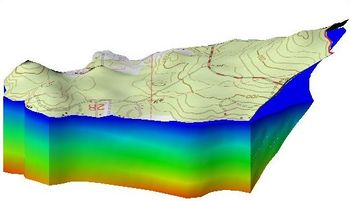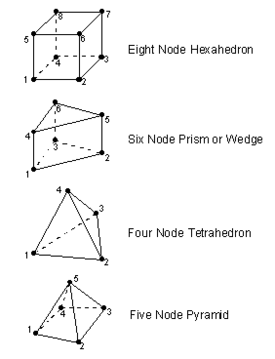GMS:3D Mesh Module: Difference between revisions
From XMS Wiki
Jump to navigationJump to search
No edit summary |
No edit summary |
||
| (13 intermediate revisions by the same user not shown) | |||
| Line 1: | Line 1: | ||
{{3D Mesh links}} | {{3D Mesh links}} | ||
The 3D Mesh module is used to create and edit 3D finite element meshes. | The 3D Mesh module is used to [[GMS:Creating a 3D Mesh|create]] and [[GMS:Editing a 3D Mesh|edit]] 3D finite element meshes. A 3D mesh consists of nodes, elements, and faces. A 3D mesh can be created from a 2D mesh, a 3D grid, 3D scatter points, or by using the automated meshing tools in GMS. | ||
Once a mesh is constructed, the [[GMS:FEMWATER|FEMWATER]] interface can be used to assign boundary conditions and analysis parameters and perform a FEMWATER analysis. | |||
3D meshes can be converted into 2D meshes, 3D scatter points, Ugrids, or solids. | The module includes [[GMS:3D Mesh Tool Palette|tools]] for manipulating 3D meshes as well as its own [[GMS:3D Mesh Commands|menu commands]] and [[GMS:3D Mesh Display Options|display options]]. 3D meshes can be [[GMS:Converting 3D Meshes to Other Data Types|converted]] into 2D meshes, 3D scatter points, Ugrids, or solids. The module also can [[GMS:Classify Material Zones|classify material zones]] and use [[GMS:Isosurfaces|isosurface]] rendering. | ||
[[Image:Sample_FEMWATER.JPG|thumb|none|left|350 px|Isosurface of Pressure Head from a FEMWATER Simulation]] | :[[Image:Sample_FEMWATER.JPG|thumb|none|left|350 px|Isosurface of Pressure Head from a FEMWATER Simulation]] | ||
Currently, only one 3D mesh can exist in a GMS project. GMS is able to work with large or complicated 3D finite element meshes. | |||
The 3D Mesh module can be added to a [http://www.aquaveo.com/software/gms-pricing paid edition] of GMS. | |||
[[Category:Link to Store]] | |||
==3D Element Types== | ==3D Element Types== | ||
Four types of 3D elements are supported by GMS: eight node hexahedra, six node prisms or wedges, four node tetrahedra, and five node pyramids. Hexahedra and wedges are created by projecting a 2D mesh. Tetrahedral elements are constructed with the '''Tessellate''' command or they can be created elsewhere and imported into GMS. | Four types of 3D elements are supported by GMS: eight node hexahedra, six node prisms or wedges, four node tetrahedra, and five node pyramids. Hexahedra and wedges are created by projecting a 2D mesh. Tetrahedral elements are constructed with the '''Tessellate''' command or they can be created elsewhere and imported into GMS. | ||
[[Image:ElemTypes1.png|thumb|none|275 px|Types of 3D elements supported by GMS]] | :[[Image:ElemTypes1.png|thumb|none|275 px|Types of 3D elements supported by GMS]] | ||
{{Navbox GMS}} | {{Navbox GMS}} | ||
[[Category:3D Mesh]] | [[Category:3D Mesh]] | ||
[[Category:Mesh Modules]] | |||


